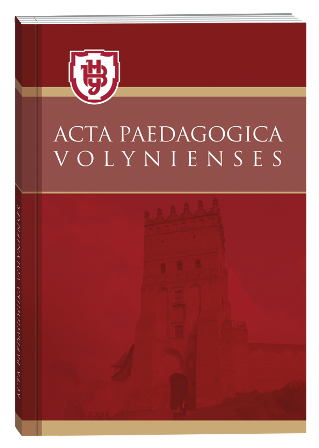FEATURES OF THE USE OF INTERMEDIA TECHNOLOGIES IN THE STUDY OF THE ART EDUCATIONAL FIELD IN ELEMENTARY SCHOOL
DOI:
https://doi.org/10.32782/apv/2025.3.9Keywords:
intermediality, intermedial technologies, artistic educational field, polyartistic education in primary schoolAbstract
The article provides a theoretical substantiation and analysis of the pedagogical conditions for using intermedial technologies in the process of studying the artistic educational field in primary school. Particular attention is given to outlining the possibilities of integrating various forms of art through digital and multimedia tools, which contributes to the development of artistic-aesthetic, creative, and digital competencies in young learners. The concept of “intermedial technologies” is contextualized within art education, and their role is highlighted as an innovative means of fostering the personal development of primary school students. The advantages of applying an intermedial approach within the New Ukrainian School are summarized, particularly in terms of enhancing learning motivation, fostering creative thinking, and forming interdisciplinary connections. The necessity of preparing teachers to work with intermedial resources and developing appropriate methodological support is substantiated. The use of intermedial technologies in the study of the artistic field in primary school is considered an important factor in modernizing the educational process in line with the conceptual principles of the New Ukrainian School. Intermediality, as a means of integrating different art forms, allows for the creation of a more variable, motivating, and creative learning environment. The findings of the study confirm that, when pedagogically appropriate, intermedial technologies support individualized learning, active student engagement in artistic activities, and the development of key competencies. Future research prospects are associated with the development of methodological models for integrating the intermedial approach into the educational practice of primary school and examining the effectiveness of digital tools in arts education.
References
Власенко І. М., Король А. М. Інтермедіальність сучасного мистецтва і технології його сприйняття. Вісник Національної академії керівних кадрів культури і мистецтв : наук. журнал. 2024. № 3. С. 38–45.
Лупак Н. Інтермедіальні технології в системі мистецької освіти як педагогічна інновація. Збірник наукових праць. Педагогічні науки. 2018. Вип LXXXIV. Херсон. Том 2. С.127–132.
Лупак Н. М. Формування комунікативної компетентності майбутніх учителів мистецтва: засади інтермедіальної технології : монографія. Тернопіль : Підручники і посібники, 2020. 452 с.
Маленко О. Інтермедіальність як естетизація художнього дискурсу: митець – мистецтво – читач. Науковий часопис НПУ ім. М. П. Драгоманова. Серія 8. Філологічні науки (мовознавство і літературознавство) : зб. наук. праць. К. : Вид-во НПУ ім. М. П. Драгоманова, 2014. Вип. 5. С. 42–50.
Малицька О. Реалізація стратегії інтермедіальності в мистецькій освіті майбутнього вчителя: методологічні підходи. Актуальнi питання гуманiтарних наук. Педагогiка. 2020. Вип. 33, том 2. С. 238–241.
Масол Л. М. Підготовка вчителів до поліхудожнього виховання учнів (теоретичні підходи й експериментальний досвід). Мистецтво та освіта. 2009. Вип. 2. С. 2–8.
Предик А. А., Мідріган Д. М. Впровадження інтермедіальних технологій при вивченні мистецької освітньої галузі в початковій школі. Дошкільна і початкова освіта в євроінтеграційному та національному вимірах : збірник матеріалів Міжнародної науково-практичної конференції (15 квітня 2025 р.). Суми : ФОП Цьома С. П., 2025. 257 с.
Просалова В. Інтермедіальність як явище мистецтва і метод аналізу. Філологічні семінари. 2013. Вип. 16. С. 46–53.
Фесенко В. І. Література і живопис: інтермедіальний дискурс : навч. посіб. Київ : КНЛУ, 2014. 398 с.
Циховська Е. Теоретичні дилеми поняття інтермедіальності. Слово і час : наук.-теорет.журнал. К. : «Фенікс», 2014. № 11. С. 49–59.








